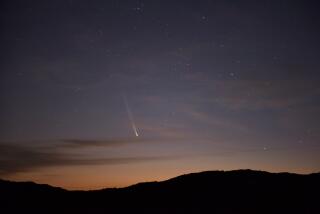Don’t mourn comet ISON yet: Sun-grazer may well survive, experts say
Will comet ISON survive its plunge into the sun’s atmosphere or will it perish, like Icarus, for venturing too close? Astronomers say that reports of its looming demise are greatly exaggerated.
ISON, known officially as C/2012 S1, is a sun-grazing comet that’s set to come within 730,000 miles of our home star’s surface in November and then hurtle by Earth in early December. It’s thought to come from the Oort cloud, a hypothesized cluster of icy objects near the solar system’s fringes, 50,000 times farther than the sun is from Earth.
Given the comet’s trajectory, this may be our only visit from ISON, as the sun’s gravity should slingshot it straight back out of the inner solar system -- that is, unless the sun fries it and rips it apart first.
This worry has plagued some comet watchers who are waiting for its much-anticipated Earth fly-by in December. The sun’s radiation could boil away its icy contents, and its intense gravitational pull could rip the comet to shreds.
But scientists say there’s no reason to count ISON out just yet. A study published in the Astrophysical Journal Letters examined historical records of cometary close encounters with the sun and found that ISON -- while we know very little about it yet -- is probably too dense to be totally shredded by the sun. At least part of the comet should survive both tidal disruption from the sun’s gravity and sublimation (the ice being boiled away straight from a solid to a gas).
“Whether or not disruption occurs, the largest remnant must be big enough to survive subsequent mass loss due to sublimation in order for ISON to remain a viable comet well after perihelion,” the authors wrote.
Scientists at the NASA Comet ISON Observing Campaign voiced the same idea.
“Does this look like a fizzled out comet?” Karl Battams, an astrophysicist at the Naval Research Laboratory in Washington, wrote in a blog post, pointing to a photo of the long-tailed, green-glowing comet taken days before.
Astronomers certainly aren’t calling it quits -- 18 spacecraft are set to image the comet.
ALSO:
Scientists make Martian clouds on Earth
A hunt for dark matter in a former gold mine
Cute yet creepy? Cube robots can self-assemble







